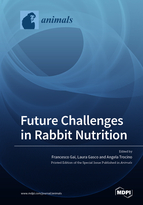Future challenges in Rabbit Nutrition
A special issue of Animals (ISSN 2076-2615). This special issue belongs to the section "Animal Nutrition".
Deadline for manuscript submissions: closed (31 December 2020) | Viewed by 18550
Special Issue Editors
Interests: aquaculture; meat; foods of animal origin; feeds; insects
Interests: animal nutrition and breeding; insects as feed; fish; poultry; rabbit
Special Issues, Collections and Topics in MDPI journals
Interests: rearing systems and welfare of growing and reproducing rabbits feeding and nutrition of rabbits feeding and nutrition of broilers myopathies in broiler chickens freshness; nutritional quality and safety of fish
Special Issue Information
Dear Colleagues,
Rabbit breeding, although a small sector of animal husbandry, is widespread in many areas of the world as rabbits are used both for food (meat) and nonfood (fur) purposes. Moreover, rabbits are also bred as companion animals, which represents a market niche for rabbit breeders.
The rabbit production chain is facing various problems, mainly concerning animal health and product quality. Gastrointestinal disorders and epizootic rabbit enteropathy are major health problems in rabbit production, causing high mortality rates around and after weaning, which affect global farm efficiency. Considering the European commitment to responsible antibiotic use in animals, rabbit nutrition and feeding play very important roles in contrasting these problems. Besides, the increasing cost of conventional feed ingredients and the increasing interest towards a circular economy push research to look for alternative raw materials that are able to provide new sources of proteins, energy, or other valuable components for rabbit diets with a sustainable environmental impact.
To overcome these issues, further studies are requested about rabbit nutrition, feeding strategies (e.g., feed restriction, phase feeding), additive supplementation (e.g., phyto-additives, immunostimulants, and probiotic and prebiotic products), and alternative raw materials.
Original manuscripts, which use a multidisciplinary approach and address any aspects of rabbit nutrition and feeding, with a direct impact on the rabbit farming, welfare, health, and meat quality, are therefore welcome. Nutrition and feeding of meat rabbits in conventional and organic systems as well as of fur and pet rabbits are welcome.
Dr. Francesco Gai
Prof. Laura Gasco
Prof. Angela Trocino
Guest Editors
Manuscript Submission Information
Manuscripts should be submitted online at www.mdpi.com by registering and logging in to this website. Once you are registered, click here to go to the submission form. Manuscripts can be submitted until the deadline. All submissions that pass pre-check are peer-reviewed. Accepted papers will be published continuously in the journal (as soon as accepted) and will be listed together on the special issue website. Research articles, review articles as well as short communications are invited. For planned papers, a title and short abstract (about 100 words) can be sent to the Editorial Office for announcement on this website.
Submitted manuscripts should not have been published previously, nor be under consideration for publication elsewhere (except conference proceedings papers). All manuscripts are thoroughly refereed through a single-blind peer-review process. A guide for authors and other relevant information for submission of manuscripts is available on the Instructions for Authors page. Animals is an international peer-reviewed open access semimonthly journal published by MDPI.
Please visit the Instructions for Authors page before submitting a manuscript. The Article Processing Charge (APC) for publication in this open access journal is 2400 CHF (Swiss Francs). Submitted papers should be well formatted and use good English. Authors may use MDPI's English editing service prior to publication or during author revisions.
Keywords
- agricultural by-products
- alternative fat and oil feed sources
- environmental sustainability
- feed efficiency
- growth performance
- immunostimulants
- meat quality
- phyto-additives
- probiotics
- unconventional plant protein sources









